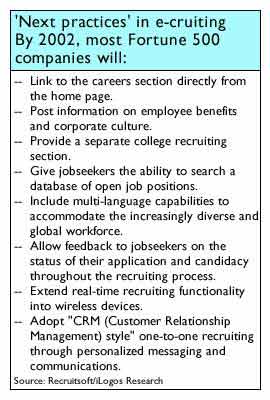|
Advertise jobs on your site
|
 |
October 30, 2000: 10:47 a.m. ET
Post openings in a career section, and sell your workplace to Web surfers
|
NEW YORK (CNNfn) - If you are not posting employment openings on your own company Web site, you probably are missing out on some good job candidates in today's tight labor market, new research suggests.
"When people go to your site, they have a relationship with you," whether as customers or simply as information-seekers, said Yves Lermusiaux, vice president of strategy and content at Recruitsoft, which provides a "hiring management system" for employers over the Internet. "As soon as you have a relationship with somebody, you can use it for different things."
For most companies on the Web, that means selling products and services. But these days especially, with the U.S. unemployment rate at 3.9 percent, a 30-year low, and a third of all Main Street employers complaining they have openings they are unable to fill, Lermusiaux said, "you have to be good at selling jobs."
That means pitching your company to site visitors as an attractive place to work, as well as shop. It means posting your vacancies so Web surfers can find them, and it means providing an easy way for people to respond.
Many corporate sites lack career sections
Yet many employers are surprisingly slow to take advantage of this opportunity to attract job-seekers. According to a new study of Fortune 500 employers by iLogos Research, a unit of Recruitsoft, 11 percent of the nation's largest companies still lack a career section on their corporate site.
| |

|
|
| |
|
|
| |
"Unless you are IBM, people may not be seeking out your site as a destination."
|
|
| |
|
|
| |

|
|
| |
|
|
| |
Ed Farrell
CareerSite Corp.
|
|
While 89 percent do at least post their job openings, only 71 percent provide an interactive feature to allow a prospect to apply for the position, the study found.
And most fail to integrate their career sections into the "supply chain" that feeds candidate information through the human resource department to the operating units that actually need the workers.
Lersmusiaux recommended also including information about your corporate culture and employee benefits in the career section, to help potential job candidates evaluate you.
A question of reach
While the study focused on the nation's largest companies, many of the recommendations are also applicable to smaller employers. One key difference, however, is a simple matter of reach. With their enormous brand awareness, the sites of giant corporations naturally attract thousands of visitors.
"Unless you are IBM, people may not be seeking out your site as a destination," said Ed Farrell, vice president of business development at CareerSite Corp. The company provides a free service to submit want ads to many different job boards and a tool to help employers manage the responses.
 "It's a good idea to leverage any free sites you can," including your own, Farrell said. He also recommended using a mix of mega-boards and niche providers, and measuring the results you get. "It's a good idea to leverage any free sites you can," including your own, Farrell said. He also recommended using a mix of mega-boards and niche providers, and measuring the results you get.
It also can be useful to use external Web sites -- or newspaper classified ads, where they allow it -- to steer job prospects back to your own company site, where you can provide more detail about the positions and to provide screening questionnaires that can help you pre-qualify the applicants.
For instance, if you are hiring for a clerical position, you might use an interactive form to inquire about an applicant's typing speed or familiarity with WordPerfect. If you have specific data-processing needs, you could ask which programming languages the person knows.
As more companies integrate the Internet into their operations, the job-recruitment function will become more sophisticated, with interactive databases of positions that job hunters can browse. The iLogos study also projects that "next practices" will include multi-language capabilities, to accommodate an increasingly diverse work force.
But one practice in the future is one that employers already should be practicing now -- responding quickly to applicants.
"In Silicon Valley, they have a saying that the life expectancy of a resume is only 72 hours," Lermusiaux said. "One way to be competitive is to make sure you respond on time." 
|
|
|
|
|
|
Recruitsoft
CareerSite
|
Note: Pages will open in a new browser window
External sites are not endorsed by CNNmoney
|
|
|
|
 |

|

